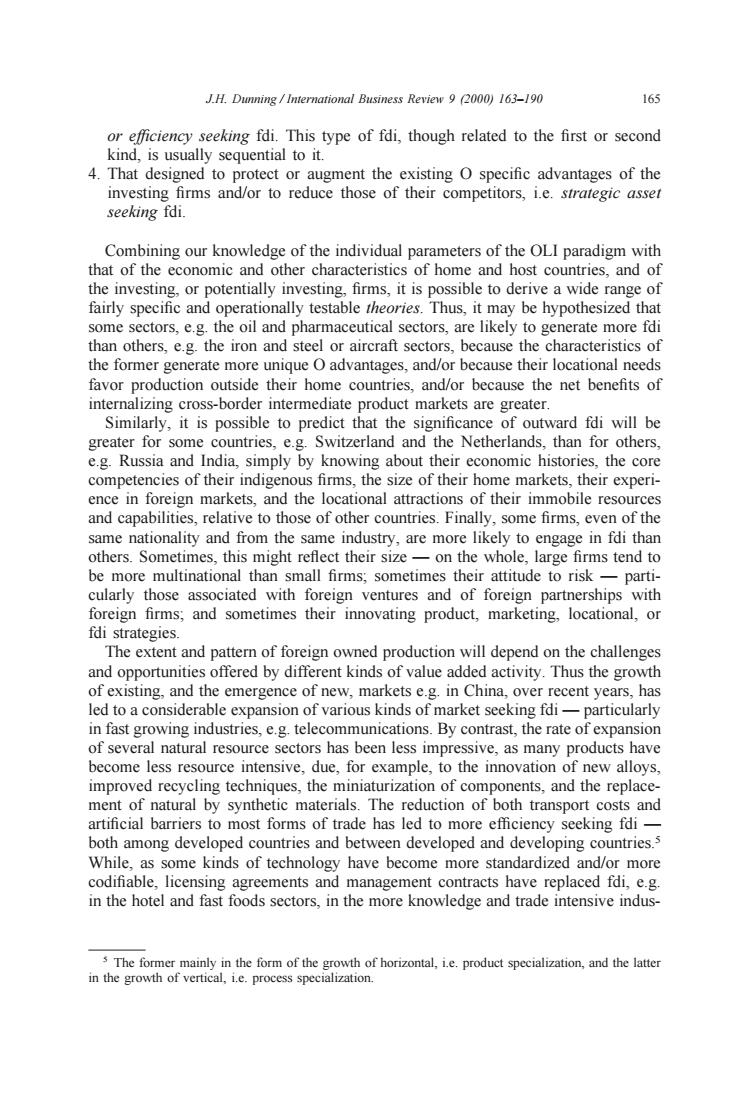正在加载图片...

JH.Dunning/International Business Review 9200)163-190 sequenti rial to it nvesti hms andor to reduce those of theit competitors,Le.strategic asser Combining our knowledge of the individual parameters of the OLI paradigm with that of the economic and other characteristics of home and host countries,and of the investing,or potentially investing,firms,it is possible to derive a wide range of fairly specific and operationally testable theories.Thus,it may be hypothesized that some sectors,e.g.the oil and pharmaceutical sectors,are likely to generate more fdi than others e g the iron and steel or aircraft sectors because the characteristics of the former generate more unique O advantages,and/or because their locational needs favor production outside their home countries.and/or because the net benefits of internalizing cross-border intermediate product markets are greater. Similarly.it is possible to predict that the significance of outward fdi will be eater for some Switzerland and the Netherlands.than for othe .g.Russia and India,simply by knowing about their e onomic histories the th of their ho markets onal thei capabil th Fin some firms same nationa rom the sa lustry,are more likely to engage in fdi others.Somet s,thi ect their size on the whole. large rms tend to more multinational than small firms;sometimes the ir attitude to risk paru cularly those associated with foreign ventures and of foreign partnerships with foreign firms;and sometimes their innovating product,marketing,locational,or fdi strategies. The extent and pattern of foreign owned production will depend on the challenges and opportunities offered by different kinds of value added activity.Thus the growth of existing,and the emergence of new,markets e.g.in China,over recent years,has led to a considerable expansion of various kinds of market seeking fdi- particularly in fast growing industries,e.g.telecommunications.By contrast,the rate of expansion of several natural resource sectors has been less impressive,as many products have become less resource intensive,due,for example,to the innovation of new alloy improved recycling techniques,the miniaturization of components,and the replac ment of natural by svntheti materials.The reduction of both tra artificial barriers to most for ms of trade has le to cy seeking fdi hoth mong develope d cou and betwee ed and deve Whil kinds of technology have become anagement contract ave repla d fdi. C.g in the hotel and s sectors,in the more knowledge and trade ntensive indus s The fo mainly in the form of the owth of horizontal,i.e.product specialization,and the latter in the growth of vertical,i..process J.H. Dunning / International Business Review 9 (2000) 163–190 165 or efficiency seeking fdi. This type of fdi, though related to the first or second kind, is usually sequential to it. 4. That designed to protect or augment the existing O specific advantages of the investing firms and/or to reduce those of their competitors, i.e. strategic asset seeking fdi. Combining our knowledge of the individual parameters of the OLI paradigm with that of the economic and other characteristics of home and host countries, and of the investing, or potentially investing, firms, it is possible to derive a wide range of fairly specific and operationally testable theories. Thus, it may be hypothesized that some sectors, e.g. the oil and pharmaceutical sectors, are likely to generate more fdi than others, e.g. the iron and steel or aircraft sectors, because the characteristics of the former generate more unique O advantages, and/or because their locational needs favor production outside their home countries, and/or because the net benefits of internalizing cross-border intermediate product markets are greater. Similarly, it is possible to predict that the significance of outward fdi will be greater for some countries, e.g. Switzerland and the Netherlands, than for others, e.g. Russia and India, simply by knowing about their economic histories, the core competencies of their indigenous firms, the size of their home markets, their experience in foreign markets, and the locational attractions of their immobile resources and capabilities, relative to those of other countries. Finally, some firms, even of the same nationality and from the same industry, are more likely to engage in fdi than others. Sometimes, this might reflect their size — on the whole, large firms tend to be more multinational than small firms; sometimes their attitude to risk — particularly those associated with foreign ventures and of foreign partnerships with foreign firms; and sometimes their innovating product, marketing, locational, or fdi strategies. The extent and pattern of foreign owned production will depend on the challenges and opportunities offered by different kinds of value added activity. Thus the growth of existing, and the emergence of new, markets e.g. in China, over recent years, has led to a considerable expansion of various kinds of market seeking fdi — particularly in fast growing industries, e.g. telecommunications. By contrast, the rate of expansion of several natural resource sectors has been less impressive, as many products have become less resource intensive, due, for example, to the innovation of new alloys, improved recycling techniques, the miniaturization of components, and the replacement of natural by synthetic materials. The reduction of both transport costs and artificial barriers to most forms of trade has led to more efficiency seeking fdi — both among developed countries and between developed and developing countries.5 While, as some kinds of technology have become more standardized and/or more codifiable, licensing agreements and management contracts have replaced fdi, e.g. in the hotel and fast foods sectors, in the more knowledge and trade intensive indus- 5 The former mainly in the form of the growth of horizontal, i.e. product specialization, and the latter in the growth of vertical, i.e. process specialization